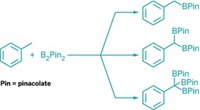Advertisement
Grab your lab coat. Let's get started
Welcome!
Welcome!
Create an account below to get 6 C&EN articles per month, receive newsletters and more - all free.
It seems this is your first time logging in online. Please enter the following information to continue.
As an ACS member you automatically get access to this site. All we need is few more details to create your reading experience.
Not you? Sign in with a different account.
Not you? Sign in with a different account.
ERROR 1
ERROR 1
ERROR 2
ERROR 2
ERROR 2
ERROR 2
ERROR 2
Password and Confirm password must match.
If you have an ACS member number, please enter it here so we can link this account to your membership. (optional)
ERROR 2
ACS values your privacy. By submitting your information, you are gaining access to C&EN and subscribing to our weekly newsletter. We use the information you provide to make your reading experience better, and we will never sell your data to third party members.
Synthesis
Dual C–H/C–H asymmetric cross-coupling unveiled
Twofold functionalization offers a green approach to generating planar chiral ferrocenes for applications as ligands and catalysts
by Stephen K. Ritter
March 14, 2016
| A version of this story appeared in
Volume 94, Issue 11
Although chemists have turned modifying unreactive C–H bonds into a routine event in organic synthesis, now and again a new approach still turns up. In one of the latest examples, De-Wei Gao, Qing Gu, and Shu-Li You of Shanghai Institute of Organic Chemistry have reported an asymmetric twofold C–H oxidative cross-coupling reaction of ferrocenes with heteroarenes that takes place without having to first prefunctionalize one or the other aryl coupling partners, which is usually required in cross-coupling strategies (J. Am. Chem. Soc. 2016, DOI: 10.1021/jacs.6b00127). The new reaction is a greener, less expensive method for preparing planar chiral ferrocenes, which are useful as chiral ligands and as asymmetric catalysts, You says. The team’s strategy involves a palladium catalyst with a protected chiral amino acid ligand that proceeds in a twofold manner, first activating the ferrocene and then the heteroarene. The atom-economical reaction avoids the need for an aryl halide or aryl organometallic precursor, proceeds using oxygen in the air as an oxidant instead of a metal oxidant, and doesn’t need a significant excess of either coupling partner. The team shows that the ferrocene derivatives can be developed as N,O and N,S and N,P bidentate planar chiral ligands and as chiral catalysts.






Join the conversation
Contact the reporter
Submit a Letter to the Editor for publication
Engage with us on Twitter